This is the last blog for the time being about art and its musical connections. I recently starting watching a television series about the history of recorded music and one of the episodes was entitled “painting sound”. This is exactly what has captivated me in recent years. Is it possible to translate musical sounds into visual art and paint music? Many of the terms used in music are common to art – composition, form, colour, texture, tone, balance, and so on. As an introduction to this blog I’ve included an extract from my sketchbook dealing with some of my early efforts to trace links on painting musical sound which began by looking at the work of Wassily Kandinsky and Paul Klee. My sketchbook contains examples of several works by these two key artists who led the investigations into art and its relationship with music, looking at shapes, colours, composition and sound. On this page of notes there is a Kandinsky work (his musically inspired Fuga) at the bottom left and also reference to a work by Georgia O’Keeffe the American artist Blue and Green Music whose wonderfully coloured works are now on display at Tate Modern, an exhibition of over 100 paintings, none of which are drawn from collections in this country.
When I listen to music there is always an emotional response of some kind either because I know something about the music – the story, the composer or songwriter(s) or the circumstances and background surrounding it. Whether I’m totally familiar with the music or unaware of what it’s about there can still be a spontaneous response just through the listening process which enables me to produce something abstract and created by chance without any prior planning. This is what I love and where I can completely indulge myself! The music can be anything – classical, contemporary or any genre that’s currently around which is moulded or explodes into a visual structure of some kind that makes sense and satisfies personally even though someone else may not understand it. There is, however, some music that has always eluded me, which is so sublime that it is almost impossible to convert it into semi-abstract visual art to match the beauty of the music. One example of this is the Four Last Songs by Richard Strauss which I simply cannot do justice too; I have tried several times and each attempt has left me disappointed and frustrated mainly because I’ve always thought they are arguably the greatest ever pieces of music written for the human female voice. Strauss and Mahler have continually challenged me with their music and perhaps one day I will produce something that is more compelling than I’ve accomplished so far!! As a general attempt at Strauss and his music here is, I think, the best so far as it was actually shown on TV during the interval of a BBC promenade concert and received positive comments from the presenter.
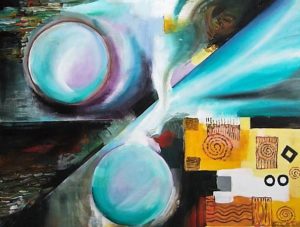
About 12 years ago in 2004 I had already started investigating responses to music through drawing and painting and decided to go to an event on the subject at Handel House in Brook Street London which consisted of a series of workshops for children about producing art from listening to various kinds of music using paint, pencils and crayons.They were asked what sort of mark or shape it would be if music sounded happy, sad, angry, peaceful or humorous. Swirls and curves were suggested for happy, straight lines at the bottom of the paper for sad, zig zags for angry, gentle lines in the middle for peaceful, bobbles and squiggles for humour. They were also told to imagine what various types of music made them think of as a scene or event such as fireworks, green countryside, battles, ceremonies or other action. The most obvious instructions related to colour with yellow for happiness and brightness, blue for sadness, red or black for anger, green and blue for peace, pink or orange for fun. Here is a record of the instructions they were given which appears in my sketchbook.
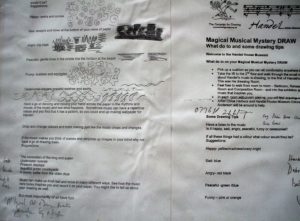
All this seemed fairly logical to me but I must confess I had already developed a much wider colour spectrum of my own and a greater range of marks to paint along to music!
At this time Tate St Ives staged a Visual Music Week featuring such links as Barbara Hepworth and Priaulx Rainier, George Crumb and Giotto, Stravinsky and Klee, Ravel and Nash. The following year I went to a seminar chaired by Tom Service (BBC music presenter and critic) on Art and Music which included the visual artist, Martin Creed, who performed a song about colours which he had written, with his band. Strauss, Stravinsky and Mahler were my first choices for trying to paint music and the following example from my sketchbook is an idea that I was going to develop from The Firebird by Stravinsky which never actually materialised into a painting.
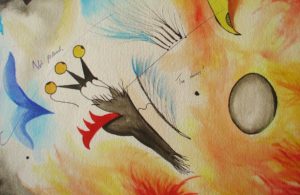
Firebird semi-abstract preparation subsequently abandoned.
Many other great composers were soon included in my experiments for the exploration of interpreting sounds and significant among them was Richard Wagner, whose music I have always loved. However, Wagner as a person is certainly not my hero and his anti-semitec views and other detestable character traits are abhorrent to me. Like many others I have separated the man from his glorious music and continue to listen and admire what he gave us. The following ideas have never finally been produced in a painting and only a few other works ever made it to board or canvas – one such painting “Epic Music” is in the Abstract gallery of the website.
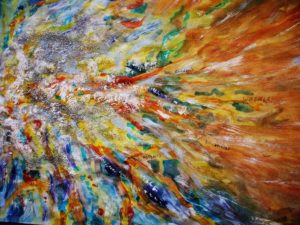
Wagnerian experiment 1
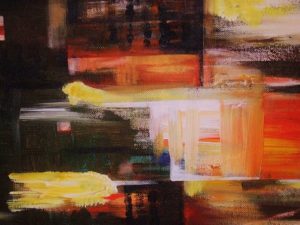
Wagnerian Experiment 2
Turning briefly now to a totally different genre of music, the band that has probably influenced me most with its sounds is Pink Floyd and I’ve spent many hours looking at the sonic patterns made by several of their songs whilst also thinking of the circumstances under which they were written which are pretty well known, as is the history of the band members Syd Barrett, Roger Walters, David Gilmor and Nick Mason. The item below relates to Shine on You Crazy Diamond (a small watercolour) all created while listening to the sounds of the song. I’ve also worked on Comfortably Numb but never yet produced a final visual version related to the music or lyrics.
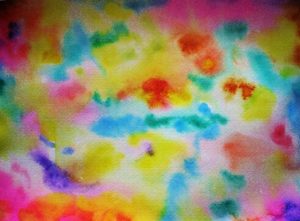
In conclusion I should repeat that the two most prominent artists to explore the art/music relationship were Wassily Kandinsky (Russian) and Paul Klee (Swiss)who were the first artists I researched when doing my preliminary work on “Painting Sound”. Both were musicians and worked together at the Bauhaus in the early twentieth century and together were the most influential and well informed artists so far to have pursued the idea that art and music are inseparable. Both men, known more for their art, could also possibly have had successful careers in music. Many of Kandinsky’s paintings had musical titles and Klee wrote a book called, unsurprisingly. Painting Music. Although this is the last reference to the subject of Painting Music and Sound for a while, I hope in the future, to return to it featuring these two artists, whose work I have admired at first hand in several exhibitions, as they are so integral to the story and history of art and music.